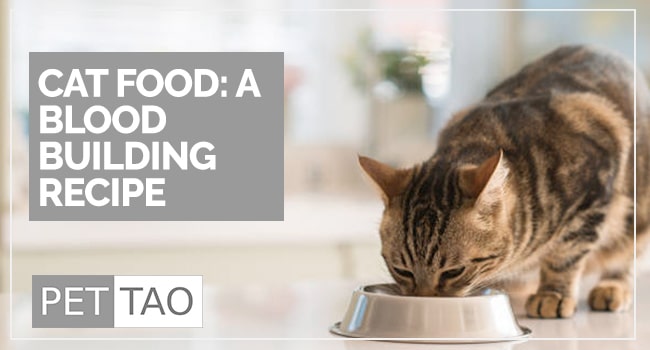When you see the term “Blood deficiency,” the first thing that pops into your mind is anemia, right?
Although anemia and Blood deficiency aren’t exactly the same, the concepts are similar.
A blood building cat food recipe boosts your cat’s Blood and gets kitty feeling better fast.
What is TCVM Blood Deficiency in a Cat?
In TCVM, “blood” is much more than the liquid red substance pumped by the heart and travels through your veins.
In TCVM, Blood provides nourishment and moisture for your cat’s entire body.
Blood keeps your cat’s tendons, skin and hair healthy, strong and flexible.
Blood lubricates the joints and nourishes the mind.
It keeps your cat calm and ensures good sleep.
The classic signs of Blood deficiency in cats are:
- Pulled ligament or cranial cruciate ligament rupture
- Dandruff, dry skin, and hair
- Pale, dry tongue
- Depression, apathy, lack of spirit
- The sallow or dull coloring
- Arthritis
- Anemia
TCVM Blood deficiency in a cat is treated by feeding the cat a diet that builds the Blood aspect of the cat’s body.
Treat Blood deficiency in cats by feeding a Blood building diet.
Creating the TCVM Blood Building Cat Food Recipe
Use Eastern Food Therapy to rebuild your cat’s blood.
A nutritionally balanced feline diet contains:
- 75% – 90% Protein – from meat
- 10% – 25% Carbohydrates – from grains, vegetables, and fruit
- A minimum of 2% fat
Use the list of foods below to create endless delicious recipe combinations for your furry friend!
Mix up the ingredients as needed to create a food that your cat loves.
You can easily track the protein, carbohydrate, and fat ratios in an online food log like the ones found on Fitbit and Livestrong websites.
You also need to add a taurine supplement to each batch of cat food you make.
For cats, taurine is an essential amino acid.
Taurine is critical for normal digestion, heart muscle function, normal vision, and maintaining a healthy immune system.
TCVM Blood Building Foods
Meats/Protein Source
Beef, red meats
Eggs
Kidney beans
Liver
Oyster
Sardine
Seeds
Tuna
Vegetables/Fruits
Sea vegetables
Beets
Dandelion
Carrots
Kale
Leafy greens
Seaweed
Spinach
Spirulina
Grains/Beans/Starch
Barley
Oatmeal
Brown rice
Whole grains
Fats
Nuts
Seeds
Olive oil
Flaxseed oil
Sample TCVM Blood Building Cat Food Recipe
3 pounds meat/dairy (see “meat/protein source” section above)
1/3 pound vegetable/fruit (see “vegetables” section above)
1/3 pound white potatoes or grains/beans (cooked weight)
¾ tablespoon olive oil
1/2 teaspoon parsley
½ teaspoon basil
Directions:
Debone and chop meat and vegetables.
Place all ingredients in crockpot layering:
- Slow cooking root vegetables on the bottom
- Meat in the middle
- Fast cooking items on top
Top with 1 cup of water.
Cook on low for 4 hours.
In addition, add the following to your pet’s diet:
- One cat multivitamin dose per day
- Calcium supplement 50mg/kg of body weight (22mg/lb of bodyweight) per day. Some other good choices for calcium are eggshell powder or bone meal.
- Taurine between 250mg and 500mg per cat per day
Feeding Schedule
Feed roughly 1/2 cup per 10 pounds of body weight twice daily.
Monitor your cat’s weight. If an undesirable weight loss occurs, please contact your veterinarian immediately so you can make an adjustment in your cat’s feeding/diet plan.
If your cat is picky, you may want to run the food through the blender prior to feeding.
When cooked this way, the vegetable pulp mixes with cooked meat juices to create a nutritious broth.
Often, cats will lap up the broth more readily than eat small vegetable chunks.
As you can see, cooking for your cat isn’t really difficult, and can be a rewarding experience for both you and your cat!
Get PET | TAO Products at TCVM Pet Supply
Please consult with your veterinarian and use personal judgment when cooking at home for your cat.
Even though pet food recalls and the poor quality of some pet foods are a concern, many veterinarians voice concerns over homemade diets.
Some vets feel that when fed exclusively, homemade diets may result in vitamin/mineral deficiencies that can adversely affect a pet’s health.
If you choose to feed your cat a homemade diet, you must understand and meet your cat’s needs to stay healthy.
Please share our recipe with your veterinarian. Your veterinarian can advise you on supplements for your pet’s individual situation.
Monitor your cat’s health by observing his/her temperament, skin, coat, and waste. If you notice anything strange, contact your veterinarian immediately.








